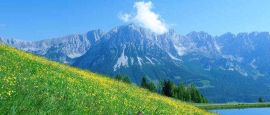Austria Weather, climate and geography
Weather & climate
Austria enjoys a moderate continental climate: summers are warm and pleasant with cool nights - perfect for hiking and biking in the Alps. Winters are sunny, with snow levels high enough for widespread winter sports. Ski season is from December to March.
The best time to visit Austria is June to September for those seeking sunshine and low rainfall, whilst November to March are ideal for those seeking winter sports.
Geography
Mountainous Austria is a landlocked country at the heart of Europe, bordered by Switzerland, Liechtenstein, Germany, the Czech Republic, the Slovak Republic, Hungary, Slovenia and Italy. The diverse landscape can be divided into five sections: the Eastern Alps (62.8%), the Alpine and Carpathian Foothills (11.3%), the Pannonian Lowlands (11.3%), the Vienna Basin (4.4%) and the Granite and Gneiss Highlands or Bohemian Massif (10.1%).
Austria's highest mountain is Grossglockner (3,798m/12,465ft) found in the Alps' Hohe Tauern range, and, on its way from the Black Forest in southern Germany to the Black Sea, the winding River Danube flows for approximately 360km (220 miles) through the country.
Nearly half of Austria is covered with forests, with the lower regions particularly densely wooded. Fir predominates above 488m (1,600ft), and gives way to larch and stone-pine beyond 1,219m (4,000ft); the Alpine foothills consist predominantly of arable land and grassland (above 610m/2,000ft); the Pannonian region is characterised by scrub and heathland.
Do you have any Feedback about this page?
© 2025 Columbus Travel Media Ltd. All rights reserved. No part of this site may be reproduced without our written permission, click here for information on Columbus Content Solutions.





 You know where
You know where